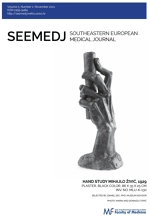Chronic Kidney Disease Related Anemia - A Narrative Review
DOI:
https://doi.org/10.26332/seemedj.v5i2.209Keywords:
chronic kidney disease;, anemia; , ironAbstract
Iron is one of the most important essential elements, required by every cell in the body. Anemia is one of the most common medical conditions, defined as a decrease in blood's ability to transport oxygen to tissues, resulting in tissue hypoxia. However, anemia is not a disease, but rather the manifestation of an underlying disorder or disease and it is an important clinical marker of a disorder that may be basic or something more complex. Therefore, once anemia has been diagnosed, the physician must determine its exact cause.
Anemia is frequently associated with chronic kidney disease (CKD) as a consequential disorder of iron metabolism and erythropoiesis regulation. It is a result of a relative erythropoietin deficiency, functional iron deficiency, impaired iron absorption, or blood loss due to dialysis. CKD related anemia is associated with an increased risk of morbidity and mortality. Given the importance of public health, it is necessary to raise CKD awareness, and to encourage early diagnosis and treatment. The recommendations and guidelines of all professional societies of nephrology emphasize early diagnosis and timely treatment. It is important to ensure that patients have a good quality of life while also minimizing the risks of further complications associated with anemia.
Downloads
Published
Issue
Section
License
Copyright (c) 2025 Southeastern European Medical Journal

This work is licensed under a Creative Commons Attribution-NonCommercial-NoDerivatives 4.0 International License.



